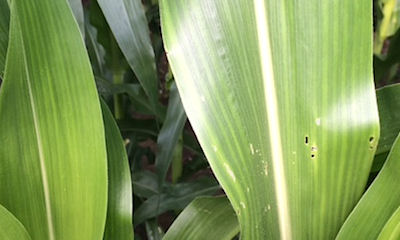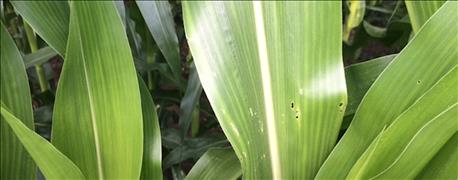June 30, 2015

The long-awaited European corn borers have begun hatching and feeding on corn plants.
In Central Indiana corn fields, I have discovered a borer in a whorl in as much as 9% of plants. This is the first generation of borers to invade the area. Second and third generations should be expected this growing season as well.
Scout's Report, 6/24: Stink bug damage and yellow leaves for Indiana corn

Scout's Report 2015: Borers are feeding in whorls; scout continues watch for moths and eggs.
The feeding that began this week appears as tiny burrow holes in a straight line across the unrolled leaves. The manure from the insects can be a good indicator of their presence as well. By pulling the whorl out of the plant and unrolling the immature leaves, the borer can be found inside. They are about 1/8th of an inch long and are a pale whitish yellow color with black heads right now.
These are very young insects at this phase, but will continue to eat and grow rapidly before reproducing. The damage can be found by walking fields and looking first in the more heavily populated areas with lush growth.
An expected yield loss of 7 bushels per borer is a rough rule of thumb when deciding what course of action to take if the field is infested.
Egg masses can also be detected in fields now, which means they will hatch and begin eating. Keep watch for flies and ladybugs that are predators to harmful insects such as these borers.
Scout's Report 6/17: Insect flight and hatching coming soon
Ideally, we would recommend spraying an insecticide between the time the egg masses hatch and when they being to burrow their way down deep into the whorls, however we also want to preserve the population of good bugs so that they will be helpful for coming generations.
If all the borers' predators are killed off before the second and third generations arrive, spraying will have to be increased. Balancing the timing and population control is crucial for the best yield come harvest time.
Kettler writes from Tipton. The Purdue University junior is an intern for Beck's Hybrids. She works with Ben Grimme, Kris Johnson and Denny Cobb
You May Also Like




